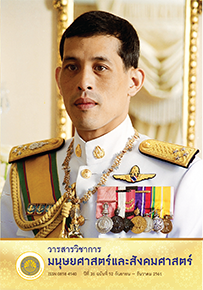Value of Public Goods Generated by National Sport Training Center (NSTC): The CVM Approach
Main Article Content
Abstract
This research aimed to valuate National Sport Training Center (NSTC), the public goods, which will be constructed by the public investment project. Although the project generates valuable public goods and positive externalities, it is difficult to value the benefits of public goods. Contingent Valuation Method (CVM) was used for valuation. The surveys were conducted and the data were then analyzed to measure the benefits such as national pride and harmony which were derived from the sports public good. The findings showed that the CVM was suitable to estimate willingness-to-pay for sports public goods or products not available in other markets. Also, there were questions asking how much sports’ value was and whether the public good was worth investing. The survey was conducted from October to November 2017 in the main provinces of each region which are Bangkok, Konkan, Chiangmai, Songkla, and Chonburi. The results were estimated by using Ordinary Least Square (OLS). From the analysis, it was found that the respondents believed that NSTC would be able to produce such public goods and they perceived the derived benefits such as national pride and harmony which were reflected from their ability to valuate concretely. From the study, it was found that the willingness to pay on national pride and harmony depended on gender, occupation, income, and interest in sports. The results revealed that the average value the respondents were willing to pay on national harmony equaled 19.24 baht per month and the average value of national pride was 20.22 baht per month. JEL: A10, H41, C49
Downloads
Article Details
บทความทุกบทความเป็นลิขสิทธิ์ของวารสารวิชาการมนุษยศาสตร์และสังคมศาสตร์ มหาวิทยาลัยบูรพาเท่านั้น
References
บวรศักดิ์ อุวรรณโณ. (2552). การเมืองไทยในปัจจุบัน. ปาฐกถาพิเศษเนื่องโอกาสการประชุมใหญ่ทางวิชาการโรงพยาบาลราชวิถี วันที่ 24 กุมภาพันธ์ 2552.
ประภาพร สีหา. (2557). ความขัดแย้งทางการเมืองกับรัฐประหาร ปี พ.ศ. 2557. วารสารรัฐศาสตร์ ปริทรรศน์ มหาวิทยาลัยเกษตรศาสตร์, 4(2), 145-166.
อรรถสิทธิ์ เมืองอินทร์. (2561). กีฬากับความสามัคคีตามแบบชาตินิยม. สืบค้นเมื่อ 6 สิงหาคม 2561 จาก https://prachatai.com/journal/2014/12/57166
Atkinson, G., Mourato S., Szymanski, S., & Ozdemiroglu, E. (2008). Are we willing to pay enough to ‘back the bid’?
Valuing the intangible impacts of London’s bid to host the 2012 Summer Olympic Games. Urban Studies, 45,
419-444.
Breuer, C., & Wicker, P. (2010). SportökonomischeAnalyse der Lebenssituation von Spitzensportlern in Deutschland
[Sports economic analysis of the life situation of elite athletes in Germany]. Bonn, Germany: Hausdruckerei des
StatistischenBundesamtes.
Hollway, S. (2001). Enduring benefits of the Olypic games for Australia. Olympic Review, 138, 28-33
Johnson, B. K., & Whitehead, J. C. (2000). Value of public goods from sports stadiums: The CVM approach. Contemporary Economic Policy, 18(1), 48.
Johnson, B. K., Groothuis, P., & Whitehead. J.C. (2001). Value of Public Goods Generated by a Major LeagueSports
Team: The CVM Approach. Journal of Sports Economics, 2(1), 6.
Mondello, M. J., & Anderson, P. (2004). Stadiums, Arenas, and Sports Referendums: A Comparative Analysis of Cities Involved in the Stadium Game. International Journal of Sport Management, (5) 43.
Owen, J.G. (2003). The Stadium Game: Cities Versus Teams. Journal of Sports Economics, 4(3), 183.
Ramchandani, G.M., Coleman, J, R., (2012) "The inspirational effects of three major sport events", International
Journal of Event and Festival Management, 3(3), 257-271.
Sussmuth, B., Heyne, M., & Maennig, W. (2010). Induced civic pride and integration. Oxford Bulletin of Economics and
Statistics, 72, 202-220.
Taks, M., Renson, R., & Vanreusel, B. (1999). Consumer expenses in sport: a marketing tool for sports and sports facility providers? European Journal for Sport Management, 6, 4-18.
Weber, W., Schnieder, C., Kortlüke, N., & Horak, B. (1995). Die wirtschaftlicheBedeutung des Sports [The economic
importance of sports]. Schorndorf, Germany: Hofmann.
Wicker, P. (2011). Willingness-to-Pay in Non-Profit Sports Clubs. International Journal of Sport Finance, 6, 155-169.


